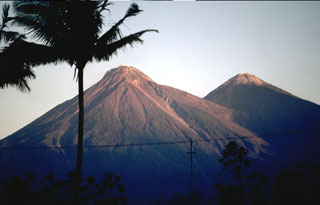Report on Fuego (Guatemala) — 18 December-24 December 2024
Smithsonian Institution / US Geological Survey
Weekly Volcanic Activity Report, 18 December-24 December 2024
Managing Editor: Sally Sennert.
Written by Zachary W. Hastings.
Please cite this report as:
Global Volcanism Program, 2024. Report on Fuego (Guatemala) (Hastings, Z W, and Sennert, S, eds.). Weekly Volcanic Activity Report, 18 December-24 December 2024. Smithsonian Institution and US Geological Survey.
Fuego
Guatemala
14.473°N, 90.88°W; summit elev. 3763 m
All times are local (unless otherwise noted)
The Instituto Nacional de Sismología, Vulcanologia, Meteorologia e Hidrología (INSIVUMEH) reported continued eruptive activity at Fuego during 18-24 December. Daily weak-to-moderately strong explosions were recorded by infrasound at rates of 6-10 per hour. The explosions generated gas-and-ash plumes that rose 4.5-5.0 km above sea level and drifted in multiple directions, including as far as 40 km SW and W. The explosions also generated block avalanches around the crater that descended toward the Ceniza (SSW), Taniluya (SSW), Las Lajas (SE), Seca (W), Santa Teresa (W), and Trinidad (SSW) drainages and sometimes as far as vegetation. On most nights and early mornings incandescent ejecta was observed as high as 250 m above the summit. This activity was accompanied by rumbling, shock waves, and sounds similar to a turbine engine. On 18 December ashfall was reported in Panimache (8 km SW), Morelia (10 km SW), Santa Sofia (12 km SW), El Porvenir (10 km S), Yepocapa (9 km NW), and other nearby communities. On 22 December ashfall was reported in San Pedro Yepocapa (9 km NW), Sangre de Cristo (10 km SW), Palo Verde (10 km SW), El Porvenir (10 km S), Panimaché (8 km SW), and other nearby communities.
Geological Summary. Volcán Fuego, one of Central America's most active volcanoes, is also one of three large stratovolcanoes overlooking Guatemala's former capital, Antigua. The scarp of an older edifice, Meseta, lies between Fuego and Acatenango to the north. Construction of Meseta dates back to about 230,000 years and continued until the late Pleistocene or early Holocene. Collapse of Meseta may have produced the massive Escuintla debris-avalanche deposit, which extends about 50 km onto the Pacific coastal plain. Growth of the modern Fuego volcano followed, continuing the southward migration of volcanism that began at the mostly andesitic Acatenango. Eruptions at Fuego have become more mafic with time, and most historical activity has produced basaltic rocks. Frequent vigorous historical eruptions have been recorded since the onset of the Spanish era in 1524, and have produced major ashfalls, along with occasional pyroclastic flows and lava flows.
Source: Instituto Nacional de Sismologia, Vulcanologia, Meteorologia, e Hidrologia (INSIVUMEH)

